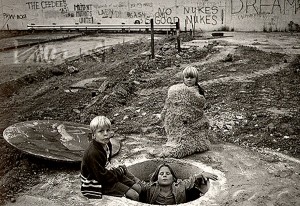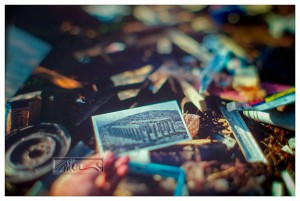Nature is the common backdrop for selling you most of the manmade goods that the world’s corporations want us to buy. We all love to think that whatever we purchase will somehow improve our experience of the world.
Whether we admit to it or not, we are driven by a desire for the natural world. The market understands our need for beauty and place. Advertisers play with the idea of a world made even better by the use of the products they push. Green or not, the product when shown in seemingly pristine nature, supports the concept that all is OK. Cars are a perfect example. Cars are usually juxtaposed against the backdrop of a twisting mountain road, roaring across an open desert or racing through some exotic landscape into a perfectly produced sunset. It is the dream of owning the thing that gets you to that other place you want to be. Nature is what sells the car. In the world of advertising, nature sells most everything.
But, finding true nature is getting more and more difficult. It seems that we have to travel far and wide to see something that has not been tainted by modern living.
It seems that the landscape is being rapidly exploited in order to produce and to sell the fantasies of our insatiable hunger for materialistic wealth. We have shifted ourselves from curious exploration to an unrelenting capitalization of the planets resources. And we’ve done so in an incredibly short time.
As we discard the things we no longer want, the environment becomes more and more filled with things like signs, wires, junk, billboards, fences, dilapidated buildings, pipes, pavement, malls, cell towers, trucks, cars, buildings, jet trails, tire marks, tires, and trash. The list goes on and on. In order to find what we all wish to see, we have to drive off the beaten path, so to speak. Even the adds show the SUV driving into the wilderness. they could care less that the message they send is destructive to the environment.
Is there still such a thing as pure nature? I would say that it might not exist on this planet. I know that it does not exist as it used to be in its previous state of natural. By previous state, I mean before the industrial revolution and before man had the powers to take or make whatever he wanted.
Personally, I believe there are still great places, which have somehow avoided man. They still have a primeval uncontaminated appearance. But, it is becoming increasingly difficult to imagine a naturally perfect world. It would seem that every corner of the planet has been disturbed by our presence.
Yes there are images that look like the world we wish for, the world that once was, the world our books describe and our parents probably knew. National Geographic and the Animal Planet provide endless imagery of those kinds of places. Photographers travel far and wide to find their best shots. There seem to be countless images of far away places that look to be unspoiled. They are the visions of our dreams and the lure of the traveler.
We can get there if we can spare the time and have the means. Money is a big factor. But once we are there, we usually find that the place is very different from the beauty depicted in the glitzy brochures. There are things we don’t see in the flyers. They only show us the good stuff – sunny days, star filled nights, great sunsets, beautiful beaches and sparkling water. There are no dark clouds in those views. After all, it is the fantasy that we are after.
They do not show the plastic bottles washed up on the shore or the dead bodies of all the birds or fish or the coral that died from the polluted waters. They do not show the Micky D’s or the giant parking lots of the mega stores, the runways or all the discard and debris that litter our planet. They don’t show us the things that are wrong – even there.
None of them show us the ecological truth about the air, the ground or the water. They don’t show us the sewage or the oil spills or the radiation, which is rapidly and repeatedly finding its way into the land, the sea and the air of every corner of the globe. Nor do they tell us the stories of those humans affected by this carelessness or show us their suffering and circumstance.
A photograph can purposely leave things out. Depending on the intent, photographs only shows us what the maker wants us to see. They are purposefully selective. We want to believe that the scenes are full circle, similar to what is outside the frame, factual and as environmentally pristine as they seem magnificent. The camera is an instrument that can be used for creating dreams. It can be used to tell only a part of the story. The camera can be used to deceive.
However, I believe it can also reveal the truth.
Yes, many of those places are probably still beautiful and perhaps exotic. It is a new experience at least from what we are used to seeing. We succumb to our desire to see what we came for and we turn our cameras towards that which brought us there. The reality is not what you are there for.
Nature is becoming something else. I believe it is dying. It is dying because we have not awakened from our fantasies. We bury our heads; choose what we want to see and what we want to know. We choose to live beyond the means of the planet. we choose to live beyond our needs.
At the end of the day, we must ask ourselves if what we want is truth or fantasy. In a world such as ours, fantasy only takes you so far. Nature needs us as much as we need it. Nature needs us to follow a logical relationship with the world and its capacity to sustain life. It is an ecosystem that we have forced out of balance.
I believe that if we all, every last one of us, could realize just how much of the world’s unique beauty (as well as our own existence) we have given up to our obsession with things and our materialistic ways, we just might be able to save what is left.
At this point, it will take a huge commitment that we all will need to seize. If we do not, and if we can survive, all we will have are images of what we believe nature seemed to be. Or, we can start believing that the world was meant to be the way we have made it.
I only wish we had thought about things long ago in order to have saved the world for our children.
The world never pretends to be what it is not. The world is factual in its evolution and in the consideration it deserves. Only man desires to live in a world of fantasy and make believe. No other creature is so inclined. All other creatures live by the rules that nature necessitates.
We live in a world that relies on cycles, where if given the chance, everything supports everything else. We live where life can only survive if it works in synchrony with the rest of life. If we want to continue as a life form, we must begin to realize our part in that play.
Denial is a human trait. It is also a human fault. Denial and opinion do not make the truth less true.
The camera can be used to deceive. But it can also help us to tell the truth as long as we recognize it.
But first, we must begin to see past ourselves and past our fantasies. We need to face our realities and maybe if we are timely, we can save what nature is left.
I would like my children to know we tried. I would like all our children to know that we woke up from our delusion and took the responsibility of adjusting ourselves to the planets needs rather than making the world succumb to us.
At this point in time it’s a fool’s paradise. But it doesn’t (or should I say…didn’t) have to be that way.
Read about my book Rethinking Digital Photography.
Please have a look at some of my other posts here.
NOTICE of Copyright: THIS POSTING AS WELL AS ALL PHOTOGRAPHS, GALLERY IMAGES, AND ILLUSTRATIONS ARE COPYRIGHT © JOHN NEEL AND ARE NOT TO BE USED FOR ANY PURPOSE WITHOUT WRITTEN CONSENT FROM THE WRITER, THE PHOTOGRAPHER AND/OR lensgarden.com. THE IDEAS EXPRESSED ARE THE PROPERTY OF THE PHOTOGRAPHER AND THE AUTHOR.



